Near the city of Cusco, amidst the lofty peaks of the Peruvian Andes, Qoyllur Rit’i is celebrated. Annually, around the time of Corpus Christi, this festival draws thousands of pilgrims from the entire region. Qoyllur Rit’i is also recognized as one of the most impressive and unique celebrations in the local festive calendar. Below, we will have a comprehensive view of this fascinating festival of the stars in the Andes and explore a bit of the history of Qoyllur Rit’i and its connection with the celebration of Tayancani.
Qoyllur Rit’i: An Ancestral Celebration.
The festivity takes place every year in May or June, coinciding with the Corpus Christi feast. Qoyllur Rit’i combines elements of the Catholic religion with ancestral Andean beliefs and traditions. For many, the name of the celebration in Quechua means “Festival of the Snow Star,” while for others, it signifies “Lord of the Bright Snow.” In the province of Quispicanchi, near Cusco, this celebration, which gathers approximately ten thousand people, takes place at over 15,748 feet above sea level.

Brief History of Qoyllur Rit’i.
In the pre-Inca era, the indigenous populations of the Andes revered Apu Ausangate, the most sacred mountain in the region, as a protective deity. It is precisely during this time that the cult of Qoyllur Rit’i is born. Later, with the arrival of Christianity during the Spanish colonization, the festival merged, giving rise to a unique blend of religious traditions.
It is said that the miraculous appearance of Christ in the form of an indigenous child on the Sinakara Mountain is the main source of this important tradition called Qoyllur Rit’i. As well as, the child Mariano Mayta, a young shepherd from the area, met the incarnation of Christ under the name of Manuel, another indigenous child. Together, they began to play and cultivate a beautiful friendship.
Upon learning of this event, adults and authorities from the place went to meet this mysterious child. At first, they could not approach to the child Manuel because of his intense brightness. When they finally managed to approach him, they could see that the child was crucified on a branch of tayanca.

Just in the same area of our story, there is an image of Christ crucified giving way to the pilgrimage of the Lord of Qoyllur Rit’i or more popularly called Lord of Qoyllority. It was thanks to the work of the painter Fabián Palomino from Cusco, that this image was engraved on a rock. The festival has become a massive pilgrimage that encompasses a wide variety of cultural expressions and provides a meeting place for communities of the Andes.
Over the years, thousands of faithful have walked long distances to pay homage to the snow star and participate in sacred rituals. Due to the mestizaje of beliefs, there are also those who decide to walk in temperatures below Zero degrees Celsius to connect with the captive nature amidst the Andes.
Curious Facts to Know.
Ancient practice linked to a trade route.
According to anthropological sources, it is believed that the emergence of this celebration and its journey through the Andes is due to knowledge of an ancient trade route between the jungle and the highlands. If you manage to finalize the route that goes from Qoyllurity to Tayankani, you can find vestiges of pre-Inca routes.
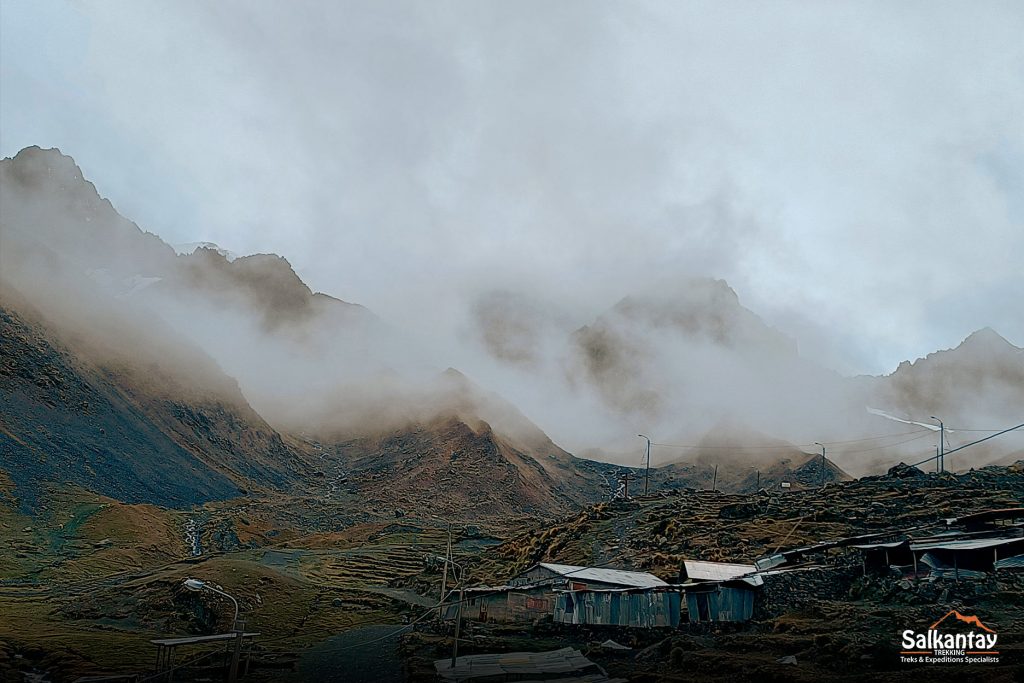
Who participates?
They are pastors, merchants, and people in general who make the pilgrimage as an important ritual of faith. After a few hours of travel, everyone gathers at the Sinakara sanctuary, where they will be accompanied by various dancers symbolizing various mythical characters. The participation of ukukus or pabluchas, chauchos, and qollas stands out. The latter perform rituals that reflect the syncretism of reverence for the image of Christ and reverence for the sacredness of nature.


Procession of religious images.
The pilgrimage includes processions with crosses that ascend to the snowy summit of the mountain and then descend. There is also a 24-hour procession. In the latter, it is the Paucartambo Nation and the Quispicanchi Nation that take the images of the Sorrowful Virgin and the Lord of Tayancani to the town of Tayancani.

What are the Nations?
Know in Spanish as “Las Naciones” they are delegations that come representing different provinces of Cusco, such as Urubamba, Anta, Tawantinsuyo, Paruro, Acomayo, Canchis, Quispicanchis, and Paucartambo. There are a total of 8 Nations, each representing a province.

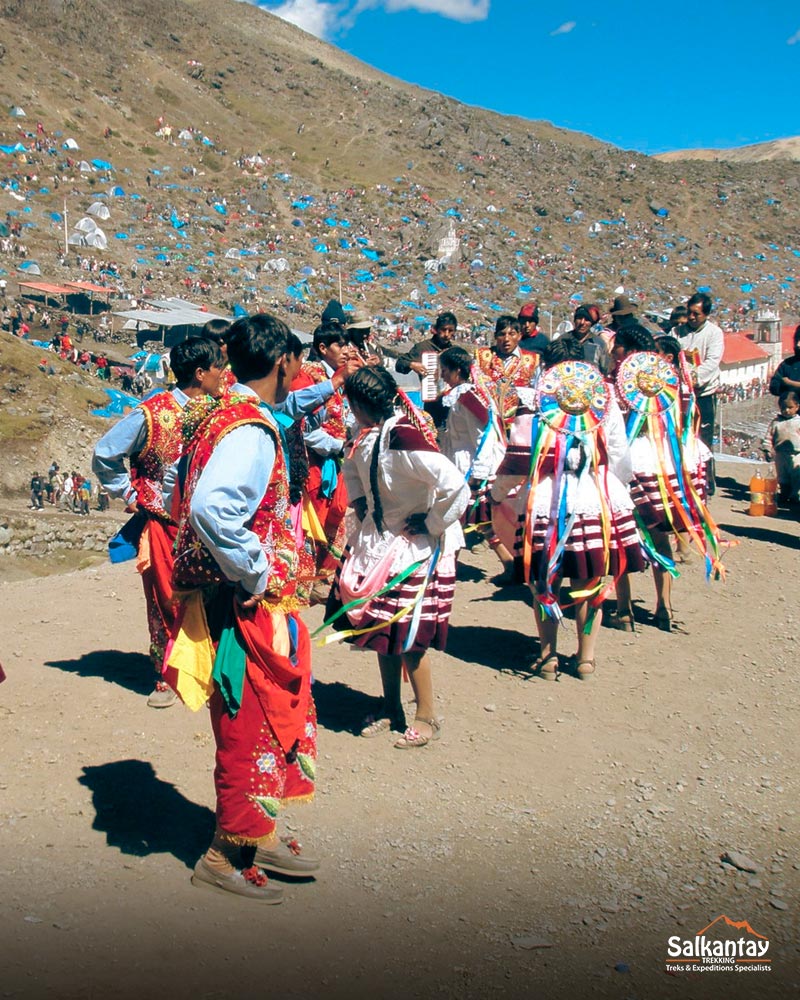
Organization and order.
The pablitos or pabluchas, characters dressed in alpaca garments wearing masks woven with wool, are in charge of order. They are responsible for enforcing the rules and solemnity of the event. The Council of Pilgrim Nations and the Brotherhood of the Lord of Qoyllur Rit’i are responsible for organizing the pilgrimage activities. Also they are who establish rules and codes of conduct.
The ukukus.
Also known as pabluchas or bears, they are the most popular characters, they are the guardians of the Lord and the Apus. They are responsible for discipline during liturgical acts. According to legend, the Ukukus are half-human, half-bear. These characters depart for the summit of the snowy mountain in search of the Snow Star. Upon returning to their communities, they will carry blocks of ice on their backs to water their lands with the sacred water from the important Ausangate snowfield.

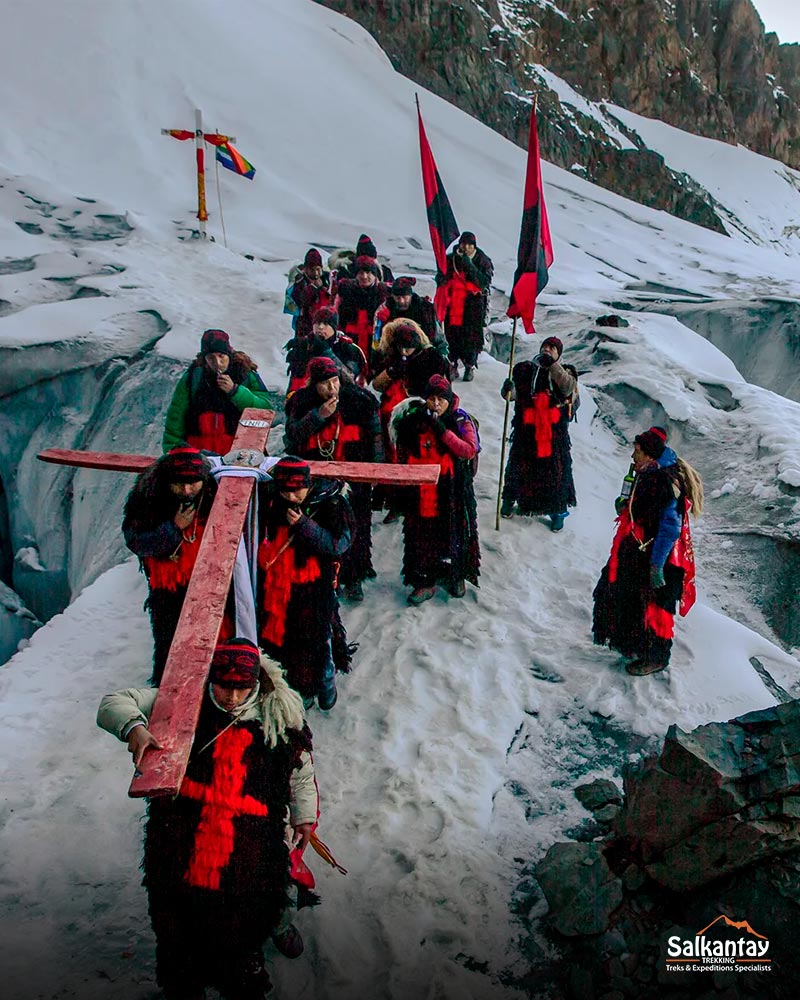
The apacheta.
It consists of the structure of a mountain of sacred stones built as an altar to Apu Ausangate. Pilgrims add stones to the apacheta as a way of gratitude and veneration, creating an impressive structure that stands as a symbol of devotion and faith.
Tayancani: The Dance of the Stars.
The dance performed in the heights of Tayancani and Sinakara is one of the most outstanding features of Qoyllur Rit’i. This dance, symbolizing the union between Catholic religion and indigenous beliefs, is performed by groups of dancers dressed in colorful traditional costumes and elaborate masks.
The Tayancani dance tells the story of the miraculous appearance of the snow star and the veneration of the Ausangate Mountain as a sacred deity. The dancers perform bold movements and customary rituals to the rhythm of traditional Andean music, creating a magical atmosphere full of energy.
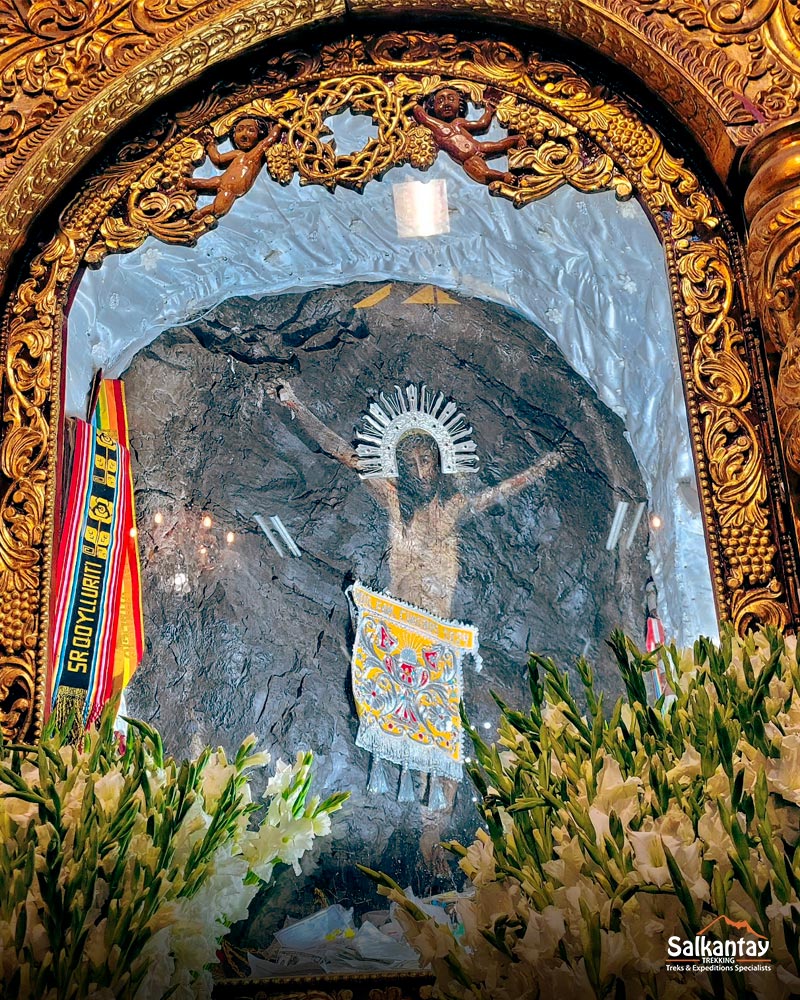
The Tayancani cross. The nations lower the cross from the town of Tayankani to Qoyllority, where it remains for a few days. Then, it returns to its place of origin, giving way to the pilgrimage to Tayankani. All nations have the duty to accompany the Lord of Tayancani back to his chapel. It is known that the cross is made of a material called tayanca.
Tayancani. Tayancani is a vast territory where pre-Inca vestiges can be seen, undoubtedly a great gift for travelers seeking to delve into the mystery and magic of the Andes. Its population is estimated at approximately 147 people. In addition to the cross, in this remote town, you can find a chapel with an image of Christ carved in the rock, just like in Qoyllurity.
The Pilgrimage and Sacred Rituals.
The highlight of Qoyllur Rit’i is the nighttime pilgrimage to the Sinakara sanctuary. During this activity, pilgrims sing, pray, and bring offerings of flowers, candles, and coca leaves to ask for blessings and protection. Without a doubt, the rituals of reaffirmation and indigenous culture take place at the top of these imposing mountains.
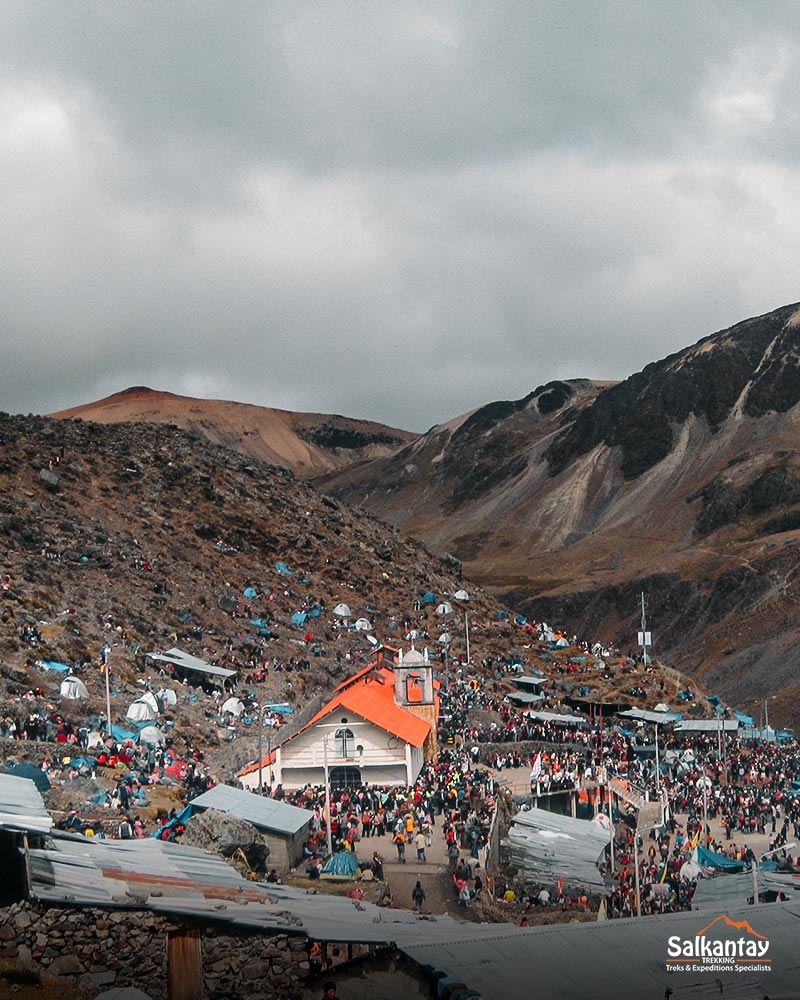

If you are looking to experience living culture, you must accompany this pilgrimage. Amidst the mountains, a beautiful performance awaits you. The pilgrimage lasts between 8 or 9 hours of walking. The main ritual is the “Inti Alabado”, in which all nations gather eagerly awaiting the first rays of sun. A blessing and aura of mysticism surround the people who surrender to their faith.
The Ch’impa. It is the dance ritual that you cannot miss because it is the fusion of all Nations into a great dance. Dancing magically amidst the Andes, its members perform geometric shapes atop the mountains, thus rewarding the participants who had the courage to get there.
Conclusion.
Qoyllur Rit’i and the celebration of Tayancani are living examples of the rich cultural and religious heritage of the Peruvian Andes. Through the fusion of Catholic religion with ancestral indigenous beliefs, this unique festival celebrates faith, tradition, and connection with nature. Qoyllur Rit’i is much more than a party for those fortunate enough to witness this celebration. It is a spiritual and cultural experience that leaves an indelible mark on the heart and soul.



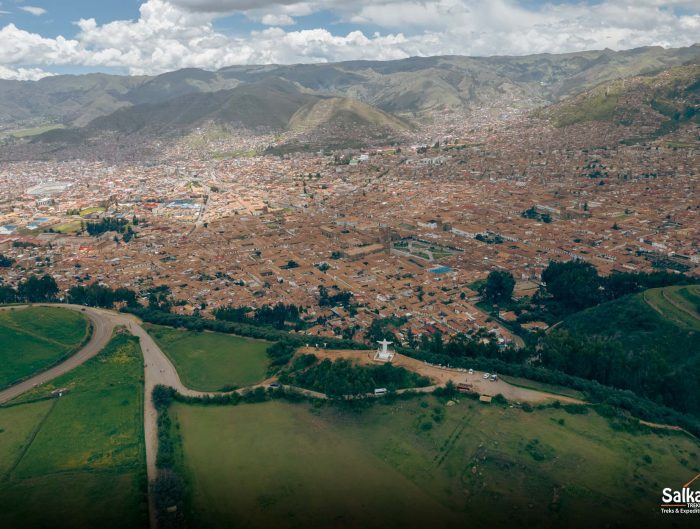










Leave A Reply